matlab基础与应用教程课后答案
Matlab编程与应用习题和一些参考答案

Matlab编程与应用习题和一些参考答案Matlab 上机实验一、二3.求下列联立方程的解⎪⎪⎩⎪⎪⎨⎧=+-+-=-+=++-=--+41025695842475412743w z y x w z x w z y x w z y x >> a=[3 4 -7 -12;5 -7 4 2;1 0 8 -5;-6 5 -2 10];>> b=[4;4;9;4];>> c=a\b4.设⎥⎥⎥⎦⎤⎢⎢⎢⎣⎡------=81272956313841A ,⎥⎥⎥⎦⎤⎢⎢⎢⎣⎡-----=793183262345B ,求C1=A*B’;C2=A’*B;C3=A.*B,并求上述所有方阵的逆阵。
>> A=[1 4 8 13;-3 6 -5 -9;2 -7 -12 -8];>> B=[5 4 3 -2;6 -2 3 -8;-1 3 -9 7];>> C1=A*B'>> C2=A'*B>> C3=A.*B>> inv(C1)>> inv(C2)>> inv(C3)5.设 ⎥⎦⎤⎢⎣⎡++=)1(sin 35.0cos 2x x x y ,把x=0~2π间分为101点,画出以x 为横坐标,y 为纵坐标的曲线。
>> x=linspace(0,2*pi,101);>> y=cos(x)*(0.5+(1+x.^2)\3*sin(x));>> plot(x,y,'r')6.产生8×6阶的正态分布随机数矩阵R1, 求其各列的平均值和均方差。
并求该矩阵全体数的平均值和均方差。
(mean var )a=randn(8,6)mean(a)var(a)k=mean(a)k1=mean(k)i=ones(8,6)i1=i*k1i2=a-i1i3=i2.*i2g=mean(i3)g2=mean(g)10.利用帮助查找limit 函数的用法,并自己编写,验证几个函数极限的例子。
MATLAB语言基础与应用(第二版)第5章 习题答案
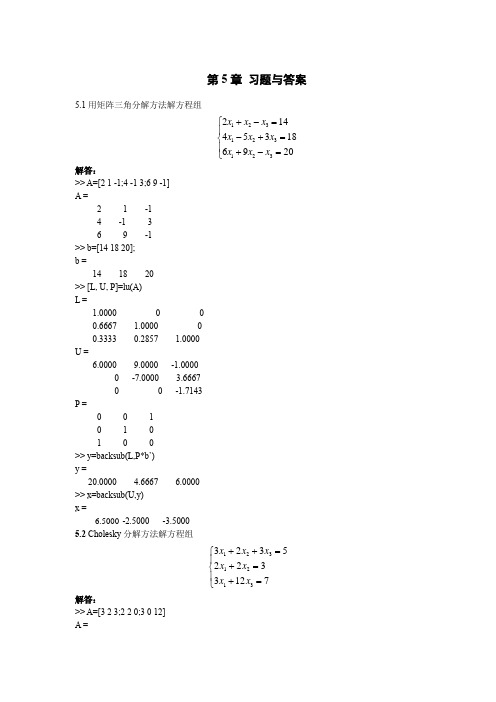
第5章习题与答案5.1用矩阵三角分解方法解方程组123123123214453186920x x x x x x x x x +-=⎧⎪-+=⎨⎪+-=⎩ 解答:>>A=[2 1 -1;4 -1 3;6 9 -1] A =2 1 -1 4 -13 6 9 -1 >>b=[14 18 20]; b =14 18 20 >> [L, U, P]=lu(A) L =1.0000 0 0 0.6667 1.0000 0 0.3333 0.2857 1.0000 U =6.0000 9.0000 -1.0000 0 -7.0000 3.6667 0 0 -1.7143 P =0 0 1 0 1 0 1 0 0 >> y=backsub(L,P*b’) y =20.0000 4.6667 6.0000 >> x=backsub(U,y) x =6.5000 -2.5000 -3.5000 5.2 Cholesky 分解方法解方程组123121332352233127x x x x x x x ++=⎧⎪+=⎨⎪+=⎩ 解答:>> A=[3 2 3;2 2 0;3 0 12] A =3 2 32 2 03 0 12>> b=[5;3;7]b =537>> L=chol(A)L =1.7321 1.1547 1.73210 0.8165 -2.44950 0 1.7321>> y=backsub(L,b)y =-11.6871 15.7986 4.0415>> x=backsub(L',y)x =-6.7475 28.8917 49.93995.3解答:观察数据点图形>> x=0:0.5:2.5x =0 0.5000 1.0000 1.5000 2.0000 2.5000 >> y=[2.0 1.1 0.9 0.6 0.4 0.3]y =2.0000 1.1000 0.9000 0.6000 0.4000 0.3000 >> plot(x,y)图5.1 离散点分布示意图从图5.1观察数据点分布,用二次曲线拟合。
matlab基础教程课后答案
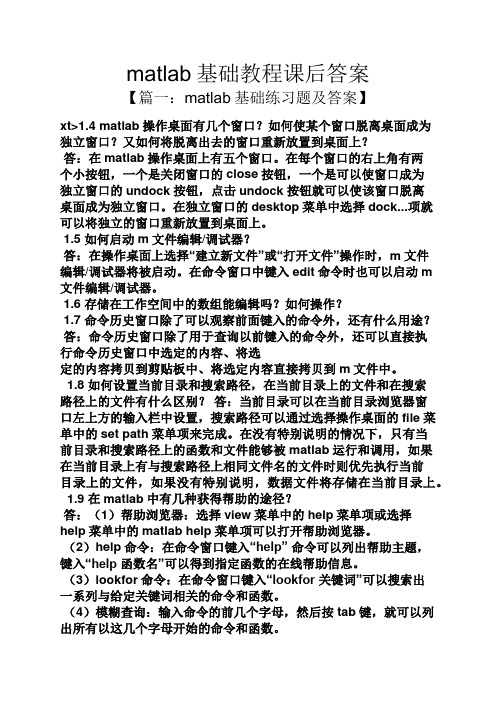
matlab基础教程课后答案【篇一:matlab基础练习题及答案】xt>1.4 matlab操作桌面有几个窗口?如何使某个窗口脱离桌面成为独立窗口?又如何将脱离出去的窗口重新放置到桌面上?答:在matlab操作桌面上有五个窗口。
在每个窗口的右上角有两个小按钮,一个是关闭窗口的close按钮,一个是可以使窗口成为独立窗口的undock按钮,点击undock按钮就可以使该窗口脱离桌面成为独立窗口。
在独立窗口的desktop菜单中选择dock...项就可以将独立的窗口重新放置到桌面上。
1.5 如何启动m文件编辑/调试器?答:在操作桌面上选择“建立新文件”或“打开文件”操作时,m文件编辑/调试器将被启动。
在命令窗口中键入edit命令时也可以启动m文件编辑/调试器。
1.6 存储在工作空间中的数组能编辑吗?如何操作?1.7 命令历史窗口除了可以观察前面键入的命令外,还有什么用途?答:命令历史窗口除了用于查询以前键入的命令外,还可以直接执行命令历史窗口中选定的内容、将选定的内容拷贝到剪贴板中、将选定内容直接拷贝到m文件中。
1.8 如何设置当前目录和搜索路径,在当前目录上的文件和在搜索路径上的文件有什么区别?答:当前目录可以在当前目录浏览器窗口左上方的输入栏中设置,搜索路径可以通过选择操作桌面的file菜单中的set path菜单项来完成。
在没有特别说明的情况下,只有当前目录和搜索路径上的函数和文件能够被matlab运行和调用,如果在当前目录上有与搜索路径上相同文件名的文件时则优先执行当前目录上的文件,如果没有特别说明,数据文件将存储在当前目录上。
1.9 在matlab中有几种获得帮助的途径?答:(1)帮助浏览器:选择view菜单中的help菜单项或选择help菜单中的matlab help菜单项可以打开帮助浏览器。
(2)help命令:在命令窗口键入“help” 命令可以列出帮助主题,键入“help 函数名”可以得到指定函数的在线帮助信息。
matlab程序设计与应用第二版习题答案

matlab程序设计与应用第二版习题答案matlab程序设计与应用第二版习题答案【篇一:matlab程序设计与应用(第二版)实验答案】%实验一 matlab运算基础%第1题%(1)z1=2*sin(85*pi/180)/(1+exp(2))%(2)x=[2,1+2i;-0.45,5];z2=0.5*log(x+sqrt(1+x.^2))%(3)a=-3.0:0.1:3.0;z3=(exp(0.3*a)-exp(-0.3*a))/2.*sin(a+0.3)+log((0.3+a)/2)%(4)t=0:0.5:2.5;z4=t.^2.*(t=0t1)+(t.^2-1).*(t=1t2)+(t.^2-2*t+1).*(t=2t3)%第2题a=[12 34 -4;34 7 87;3 65 7];b=[1 3 -1;2 0 3;3 -2 7];a+6*ba-b+eye(size(a))a*ba.*ba^3a.^3a/bb\a[a,b][a([1,3],:);b^2]%第3题a=[1 2 3 4 5;6 7 8 9 10;11 12 13 14 15;16 17 18 19 20;21 22 23 24 25] b=[3 0 16;17 -6 9;0 23 -4;9 7 0;4 13 11]c=a*bf=size(c)d=c(f(1)-2:f(1),f(2)-1:f(2))whos%第4题%(1):a=100:999;b=rem(a,21);c=length(find(b==0))%(2):a=lsdhksdlkklsdkl;k=find(a=aa=z);a(k)=[]%实验二 matlab矩阵分析与处理 %第1题e=eye(3);r=rand(3,2);o=zeros(2,3);s=diag([2,3]);a=[e,r;o,s];a^2b=[e,(r+r*s);o,s^2]%第2题h=hilb(5)p=pascal(5)hh=det(h)hp=det(p)th=cond(h)tp=cond(p)%第3题a=fix(10*rand(5))h=det(a)trace=trace(a)rank=rank(a)norm=norm(a)%第4题a=[-29,6,18;20,5,12;-8,8,5][v,d]=eig(a)%数学意义略%第5题方法一%(1):a=[1/2,1/3,1/4;1/3,1/4,1/5;1/4,1/5,1/6]; b=[0.95,0.67,0.52]; x=inv(a)*b%(2):b=[0.95,0.67,0.53];x=inv(a)*b%(3):cond(a)%第5题方法二a=hilb(4)a(:,1)=[]a(4,:)=[]b=[0.95,0.67,0.52];x=inv(a)*bb1=[0.95,0.67,0.53];x1=inv(a)*b1n=cond(b)n1=cond(b1)na=cond(a) %矩阵a为病态矩阵%第6题a=[1,4,9;16,25,36;49,64,81]b=sqrtm(a)c=sqrt(a) %sqrtm函数是以矩阵为单位进行计算,sqrt函数是以矩阵中的元素进行计算%实验三选择程序结构设计%第1题程序一x=[-5.0,-3.0,1.0,2.0,2.5,3.0,5.0];y=[]; %建立存放所有y值的矩阵for x0=xif x00x0~=-3y=[y,x0*x0+x0-6];elseif x0=0x05x0~=2x0~=3y=[y,x0*x0-5*x0+6];elsey=[y,x0*x0-x0-1];endendx%输出所有xy%输出所有y%第1题程序二x=[-5,-3,1,2,2.5,3,5];y=[];for a=1:7if x(a)0x(a)~=-3y=[y,(x(a))^2+x(a)-6];elseif x(a)=0x(a)5x(a)~=2x(a)~=3y=[y,(x(a))^2-5*x(a)+6];elsey=[y,x(a)*x(a)-x(a)-1];endend%第2题程序一x=input(请输入一个百分制成绩:);if x100|x0disp(您输入的成绩不是百分制成绩,请重新输入。
MATLAB基础及其应用教程-周开利-邓春晖课后答案,第三章
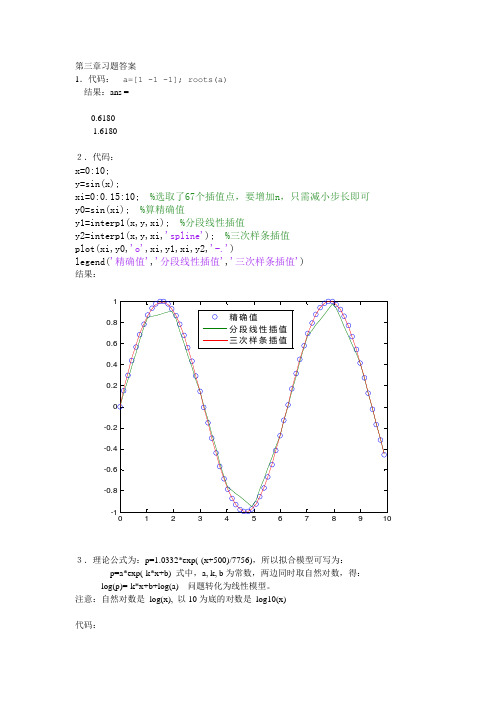
第三章习题答案1.代码:a=[1 -1 -1]; roots(a)结果:ans =-0.61801.61802.代码:x=0:10;y=sin(x);xi=0:0.15:10; %选取了67个插值点,要增加n,只需减小步长即可y0=sin(xi); %算精确值y1=interp1(x,y,xi); %分段线性插值y2=interp1(x,y,xi,'spline'); %三次样条插值plot(xi,y0,'o',xi,y1,xi,y2,'-.')legend('精确值','分段线性插值','三次样条插值')结果:3.理论公式为:p=1.0332*exp(-(x+500)/7756),所以拟合模型可写为:p=a*exp(-k*x+b) 式中,a, k, b为常数,两边同时取自然对数,得:log(p)=-k*x+b+log(a)问题转化为线性模型。
注意:自然对数是log(x), 以10为底的对数是log10(x)代码:clear;x=[0 300 600 1000 1500 2000];p=[0.9689 0.9322 0.8969 0.8519 0.7989 0.7491];lnp=log(p); %转化为 p 的自然对数值,模型转化为线性模型pk=polyfit(x,lnp,1); % 线性拟合,得到模型的斜率pk(1)和常数pk(2) 模型为: p=exp(pk(1)*x)*exp(pk(2))xi=0:50:2000;p0=1.0332*exp(-(xi+500)/7756); %理论值p1=exp(pk(1)*xi+pk(2)); %拟合模型值p2=interp1(x,p,xi,'spline'); %三次样条插值plot(x,p,'p',xi,p0,xi,p1,'--',xi,p2,'-.');legend('测量值','理论值','拟合值','三次样条值');format long % 数据显示格式为15位有效数字x2=0:200:2000 % 取10个点,比较差异pp1=1.0332*exp(-(x2+500)/7756) %理论值pp2=exp(pk(1)*x2+pk(2)) % 拟合值pp3=interp1(x,p,x2,'spline') % 样条插值err1=sum(abs(pp2-pp1).^2) % 拟合值的误差绝对值总和err2=sum(abs(pp3-pp1).^2) % 样条值的误差绝对值总和结果:0200400600800100012001400160018002000从图像上,都符合得很好,但很难看出差异。
matlab程序设计与应用第二版习题答案

matlab程序设计与应用第二版习题答案Matlab程序设计与应用第二版习题答案Matlab是一种强大的数学软件,广泛应用于科学计算、数据分析和工程设计等领域。
《Matlab程序设计与应用》是一本经典的教材,对于学习和掌握Matlab编程语言具有重要的意义。
本文将为大家提供《Matlab程序设计与应用第二版》中部分习题的答案,帮助读者更好地理解和应用Matlab。
第一章:Matlab基础1.1 基本操作1. a = 3; b = 4; c = sqrt(a^2 + b^2); disp(c);2. x = linspace(-pi, pi, 100); y = sin(x); plot(x, y);3. A = [1 2 3; 4 5 6; 7 8 9]; B = [9 8 7; 6 5 4; 3 2 1]; C = A + B; disp(C);1.2 控制结构1. for i = 1:10disp(i);end2. n = 0; sum = 0; while sum < 100n = n + 1;sum = sum + n;enddisp(n);3. x = 5; if x > 0disp('x is positive');elseif x < 0disp('x is negative');elsedisp('x is zero');end第二章:向量和矩阵运算2.1 向量运算1. A = [1 2 3]; B = [4 5 6]; C = A .* B; disp(C);2. A = [1 2 3]; B = [4 5 6]; C = A ./ B; disp(C);3. A = [1 2 3]; B = [4 5 6]; C = dot(A, B); disp(C);2.2 矩阵运算1. A = [1 2 3; 4 5 6]; B = [7 8; 9 10; 11 12]; C = A * B; disp(C);2. A = [1 2 3; 4 5 6]; B = [7 8; 9 10; 11 12]; C = B * A; disp(C);3. A = [1 2 3; 4 5 6]; B = [7 8; 9 10; 11 12]; C = A .* B; disp(C); 第三章:函数和脚本文件3.1 函数1. function y = myfunc(x)y = x^2 + 3*x + 2;end2. function [y1, y2] = myfunc(x1, x2)y1 = x1^2 + 3*x1 + 2;y2 = x2^2 + 3*x2 + 2;end3. function [y1, y2] = myfunc(x)y1 = x^2 + 3*x + 2;y2 = sin(x);end3.2 脚本文件1. x = linspace(0, 2*pi, 100); y = sin(x); plot(x, y);2. x = linspace(-10, 10, 100); y = x.^2 + 3*x + 2; plot(x, y);3. x = linspace(0, 2*pi, 100); y1 = sin(x); y2 = cos(x); plot(x, y1, x, y2);通过以上习题的答案,读者可以对Matlab程序设计的基本语法和常用函数有一个初步的了解。
matlab基础与应用教程课后答案
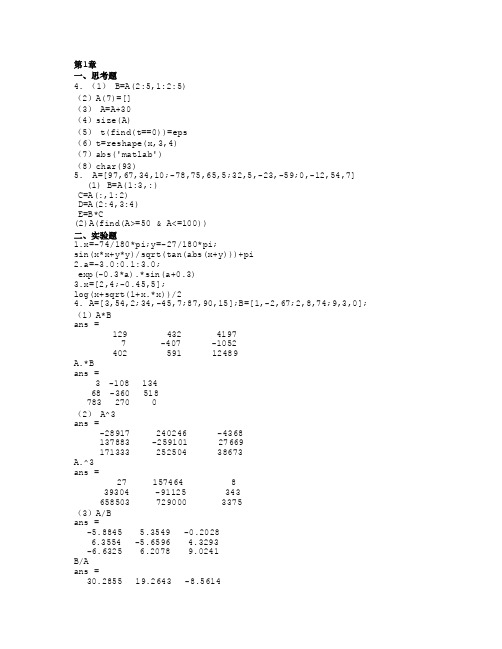
x=3*exp(-t); % 求各采样点样本值x
dt=t(2)-t(1); f=1/dt;
% 采样周期 % 采样频率(Hz)
X=fft(x);
% 计算x的快速傅立叶变换X
F=X(1:N/2+1); f=f*(0:N/2)/N;
% F(k)=X(k)(k=1:N/2+1) % 使频率轴f从零开始
plot(f,abs(F),'-*')
(2)A(7)=[]
(3) A=A+30
(4)size(A)
(5) t(find(t==0))=eps
(6)tபைடு நூலகம்reshape(x,3,4)
(7)abs('matlab')
(8)char(93)
5. A=[97,67,34,10;-78,75,65,5;32,5,-23,-59;0,-12,54,7]
8. x=linspace(-3,3,100);y=linspace(-3,3,100); [x y]=meshgrid(x,y); fxy=-5./(1+x.^2+y.^2); i=find(abs(x)<=0.8 & abs(y)<=0.5);
fxy(i)=NaN; surf(x,y,fxy) 9. u=linspace(1,10,100);v=linspace(-pi,pi,100); [u,v]=meshgrid(u,v); x=3.*u.*sin(v);y=2.*u.*cos(v);z=4*u.^2; x=3*u.*sin(v);y=2*u.*cos(v);z=4*u.^2; surf(x,y,z);shading interp; light('position',[1,0,1]); 10.
MATLAB基础及其应用教程周开利邓春晖课后答案
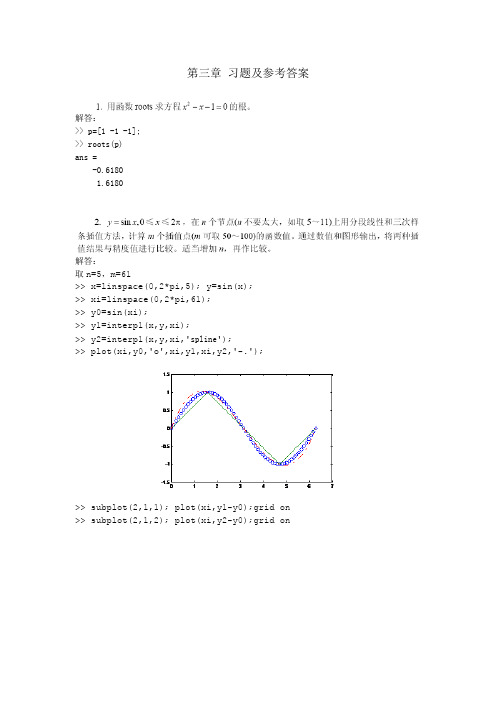
第三章习题及参考答案解答:>> p=[1 -1 -1];>> roots(p)ans =-0.61801.6180解答:取n=5,m=61>> x=linspace(0,2*pi,5); y=sin(x);>> xi=linspace(0,2*pi,61);>> y0=sin(xi);>> y1=interp1(x,y,xi);>> y2=interp1(x,y,xi,'spline');>> plot(xi,y0,'o',xi,y1,xi,y2,'-.');>> subplot(2,1,1); plot(xi,y1-y0);grid on >> subplot(2,1,2); plot(xi,y2-y0);grid on分段线性和三次样条插值方法与精确值之差取n=11,m=61>> x=linspace(0,2*pi,11); y=sin(x);>> xi=linspace(0,2*pi,61);>> y0=sin(xi);>> y1=interp1(x,y,xi);>> y2=interp1(x,y,xi,'spline');>> plot(xi,y0,'o',xi,y1,xi,y2,'-.');>> subplot(2,1,1); plot(xi,y1-y0);grid on>> subplot(2,1,2); plot(xi,y2-y0);grid on分段线性和三次样条插值方法与精确值之差解答:>> x=[0,300,600,1000,1500,2000];>> y=[0.9689,0.9322,0.8969,0.8519,0.7989,0.7491]; >> xi=0:100:2000;>> y0=1.0332*exp(-(xi+500)/7756);>> y1=interp1(x,y,xi,'spline');>> p3=polyfit(x,y,3);>> y3=polyval(p3,xi);>> subplot(2,1,1);plot(xi,y0,'o',xi,y1,xi,y3,'-.'); >> subplot(2,1,2);plot(xi,y1-y0,xi,y3-y0);grid on插值和拟合方法相比较,都合理,误差也相近。
MATLAB及其应用课后习题解答

5
“MATLAB 及其应用”课程作业
图 4- 2 画出函数图像
第5章
1. 已知椭圆的长、短轴 a 4, b 2 ,用“小红点线”画如下图所示的椭圆
x a cos t 。 y b sin t
(提示:参量 t ;点的大小;axis equal) 答 : 运 行 :clf; a=4;b=2;t=0:pi/80:2*pi;x=a*cos(t);y=b*sin(t);plot(x,y,’r’,’markersize’,15);axis equal;xlabel(‘x’);ylabel(‘y’);shg;结果如图 5-1 所示:
1
“MATLAB 及其应用”课程作业
a5=sin(sym(pi/4)+exp(sym(0.7+pi/3))); a6=sin(sym(pi/4)+sym(exp(0.7+pi/3))); a7=sin(sym(pi/4+exp(0.7+pi/3))); a8=sym(sin(pi/4+exp(0.7+pi/3))); da2 = vpa(a1-a2,30) da3 = vpa(a1-a3,30) da4 = vpa(a1-a4,30) da5 = vpa(a1-a5,30) da6 = vpa(a1-a6,30) da7 = vpa(a1-a7,30) da8 = vpa(a1-a8,30) 结果如图 2-2 所示: 只有 a2 是精准的,观察可知,这是由 于 sym('Num')和 sym(Num)的区别带来 图 2- 2 vpa 观察误差 的前者以字符串的形式传给符号运算内 核,可以保留完整的精度;而后者经过浮点数运算之后再转换为符号类型,存在精度损 失。 3.在不加专门指定的情况下,以下符号表达式中的哪一个变量被认为是独立自由变量。 sym('sin(w*t)') , sym('a*exp(-X)' ) , sym('z*exp(j*th)') 答:分别为 w,a,z,具体图 2-3 所示。
MATLAB基础及其应用教程周开利邓春晖课后答案

第三章习题及参考答案解答:>> p=[1 -1 -1];>> roots(p)ans =-0.61801.6180解答:取n=5,m=61>> x=linspace(0,2*pi,5); y=sin(x);>> xi=linspace(0,2*pi,61);>> y0=sin(xi);>> y1=interp1(x,y,xi);>> y2=interp1(x,y,xi,'spline');>> plot(xi,y0,'o',xi,y1,xi,y2,'-.');>> subplot(2,1,1); plot(xi,y1-y0);grid on>> subplot(2,1,2); plot(xi,y2-y0);grid on分段线性和三次样条插值方法与精确值之差取n=11,m=61>> x=linspace(0,2*pi,11); y=sin(x);>> xi=linspace(0,2*pi,61);>> y0=sin(xi);>> y1=interp1(x,y,xi);>> y2=interp1(x,y,xi,'spline');>> plot(xi,y0,'o',xi,y1,xi,y2,'-.');>> subplot(2,1,1); plot(xi,y1-y0);grid on>> subplot(2,1,2); plot(xi,y2-y0);grid on分段线性和三次样条插值方法与精确值之差解答:>> x=[0,300,600,1000,1500,2000];>> y=[0.9689,0.9322,0.8969,0.8519,0.7989,0.7491]; >> xi=0:100:2000;>> y0=1.0332*exp(-(xi+500)/7756);>> y1=interp1(x,y,xi,'spline');>> p3=polyfit(x,y,3);>> y3=polyval(p3,xi);>> subplot(2,1,1);plot(xi,y0,'o',xi,y1,xi,y3,'-.');>> subplot(2,1,2);plot(xi,y1-y0,xi,y3-y0);grid on插值和拟合方法相比较,都合理,误差也相近。
matlab基础与应用教程课后答案

matlab基础与应用教程课后答案【篇一:matlab教程基本应用练习题及解答】txt>要求:将每题的答案(命令行和运行结果、图片或m文件的文件名及具体内容)直接拷贝插入到各题的下方:(1)若为命令行,要求将提示符“”一起拷入,并在右侧用“%”注明命令行的每条命令的作用;(2)若为多个运行结果,拷入后要求解释每个结果具体对应题目中的哪个要求,也在右侧用“%”注明;(3)如果为m文件,除了将文件名和此文件的具体内容全部拷入外,再将所有原始m文件和本练习题电子版放在一个以“专业班级+本人姓名+学号”命名的文件夹内一起上传。
ans =1 0 00 1 00 0 1ans =0 0 00 0 0ans =1 1 11 1 11 1 11 1 120+40*rand(1,10) %生成10个在区间[20,60]上均匀分布的随机数。
ans =44.617351.677556.872549.528327.050636.228257.418856.676236 .410855.7460二.1)计算向量(2,4,6,8)的最大值,最小值,平均值,中值,排序,总和值; max([2,4,6,8])%最大值ans =8min([2,4,6,8])% 最小值ans =2mean([2,4,6,8])% 平均值ans =5median([2,4,6,8])% 中值ans =5sort([2,4,6,8])% 排序ans =2 4 6 8sum([2,4,6,8])% 总和值ans =202)在行向量(2,4,6,8)和(1,3,5,7)之间实施加减乘除及幂运算; a=[2 4 6 8];b=[1 3 5 7];a+b%加ans =3 7 11 15a-b%减ans =1 1 1 1a.*b%乘ans =2 12 30 56a./b%除ans =2.0000 1.3333 1.2000 1.1429a.^b%幂ans =2 64 7776 20971523)在向量(1,3,5)与标量2之间实施加减乘除及幂运算。
matlab基础与应用部分习题答案
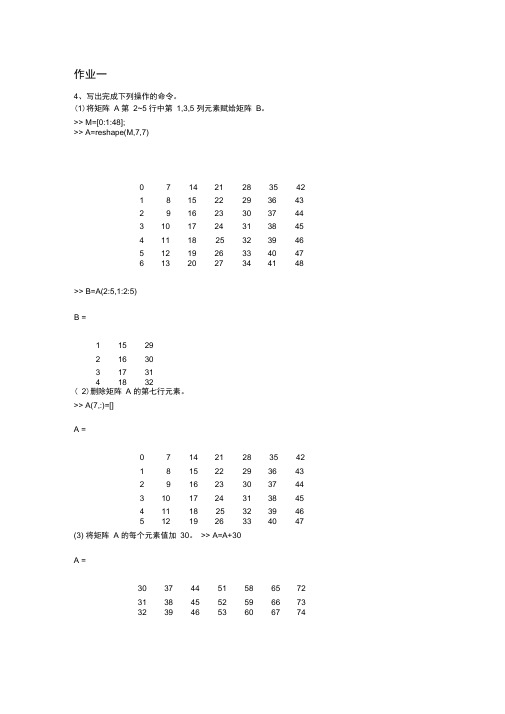
作业一4、写出完成下列操作的命令。
(1)将矩阵 A 第2~5 行中第1,3,5 列元素赋给矩阵B。
>> M=[0:1:48];>> A=reshape(M,7,7)0 7 14 21 28 35 421 8 15 22 29 36 432 9 16 23 30 37 443 10 17 24 31 38 454 11 18 25 32 39 465 12 19 26 33 40 476 13 20 27 34 41 48 >> B=A(2:5,1:2:5)B =1 15 292 16 303 17 314 18 32( 2)删除矩阵 A 的第七行元素。
>> A(7,:)=[]A =0 7 14 21 28 35 421 8 15 22 29 36 432 9 16 23 30 37 443 10 17 24 31 38 454 11 18 25 32 39 465 12 19 26 33 40 47 (3) 将矩阵A 的每个元素值加30。
>> A=A+30A =30 37 44 51 58 65 7231 38 45 52 59 66 7332 39 46 53 60 67 7433 40 47 54 61 68 7534 41 48 55 62 69 7635 42 49 56 63 70 77(4 求矩阵A 的大小和维素。
sizeA = size(A)dA = ndims(A) sizeA = dA =2(5)将向量t的0元素用机器零来代替。
>> t=[1 2 3 4 0 5];t =1 2 3 4 0 5>> find(t==0)ans =5>> t(5)=epst =1.00002.00003.00004.0000 0.00005.0000(6)将含有12个元素的向量x 转换成3*4 矩阵。
>> x=[0:11]x =0 1 2 3 4 5 6 7 8 9 10 >>11 y=reshape(x,3,4)y =0 3 6 91 4 7 102 5 8 117)求一个字符串的ASCII。
MATLAB基础与应用第二版课后习题答案

通信电路仿真上机试题班级:姓名:学号:第一章4.gcd函数用于求两个数的最大公约数。
现拥有help命令查看该函数的用法,然后利用该函数15和35的最大约数。
程序: >> help gcdGCD Greatest common divisor.G = GCD(A,B) is the greatest common divisor of correspondingelements of A and B. The arrays A and B must contain non-negativeintegers and must be the same size (or either can be scalar).GCD(0,0) is 0 by convention; all other GCDs are positive integers.[G,C,D] = GCD(A,B) also returns C and D so that G = A.*C + B.*D.These are useful for solving Diophantine equations and computingHermite transformations.See also LCM.结果:>> g=gcd(15,35)g =56.以致三角形的三边a=9.6,b=13.7,c=19.4,求三角形的面积。
提示:利用海伦公式area=sqrt(s*(s-a)*(s-b)*(s-c))计算,其中s=(a+b+c)/2。
程序:clearclca=9.6,b=13.7,c=19.4s=(a+b+c)/2area=sqrt(s*(s-a)*(s-b)*(s-c))结果:a = 9.6000 b =13.7000 c = 19.4000 s = 21.3500 area = 61.1739第二章5.计算下列分段函数0 x<=5F(x)= (x-3)/4 5<x<=102*x x>10程序:clearclcx=input('请输入一个数,x=');if x<=5y=0;elseif x>5&x<=10y=(x-3)/4;else x>10y=2*x;endy结果:请输入一个数,x=11y =228.已知S=1+2+2^2+2^3+…+2^63,求S 的值。
MATLAB程序设计与应用(第二版)课后实验答案

Matlab课后实验题答案实验一 MATLAB运算基础1. 先求下列表达式的值,然后显示MATLAB工作空间的使用情况并保存全部变量。
(1)0 122sin851ze =+(2)21ln(2z x=,其中2120.455ix+⎡⎤=⎢⎥-⎣⎦(3)0.30.330.3sin(0.3)ln, 3.0, 2.9,,2.9,3.0 22a ae e az a a--+=++=--(4)2242011122123t tz t tt t t⎧≤<⎪=-≤<⎨⎪-+≤<⎩,其中t=0:0.5:2.52. 已知:1234413134787,2033657327A B --⎡⎤⎡⎤⎢⎥⎢⎥==⎢⎥⎢⎥⎢⎥⎢⎥-⎣⎦⎣⎦求下列表达式的值:(1) A+6*B 和A —B+I(其中I 为单位矩阵) (2) A*B 和A.*B (3) A^3和A.^3 (4) A/B 及B\A(5) [A,B ]和[A ([1,3],:);B^2] 解:3. 设有矩阵A 和B123453166789101769,111213141502341617181920970212223242541311A B ⎡⎤⎡⎤⎢⎥⎢⎥-⎢⎥⎢⎥⎢⎥⎢⎥==-⎢⎥⎢⎥⎢⎥⎢⎥⎢⎥⎢⎥⎣⎦⎣⎦(1) 求它们的乘积C 。
(2) 将矩阵C 的右下角3×2子矩阵赋给D 。
(3) 查看MATLAB 工作空间的使用情况。
4. 完成下列操作:(1) 求[100,999]之间能被21整除的数的个数。
(2) 建立一个字符串向量,删除其中的大写字母。
解:(1) 结果:(2).建立一个字符串向量 例如: ch='ABC123d4e56Fg9';则要求结果是:实验二 MATLAB 矩阵分析与处理1。
设有分块矩阵33322322E R A O S ⨯⨯⨯⨯⎡⎤=⎢⎥⎣⎦,其中E 、R 、O 、S 分别为单位矩阵、随机矩阵、零矩阵和对角阵,试通过数值计算验证22E R RS A OS +⎡⎤=⎢⎥⎣⎦。
MATLAB基础与应用教程 习题答案 作者 蔡旭晖 刘卫国 蔡立燕 第1-8章答案
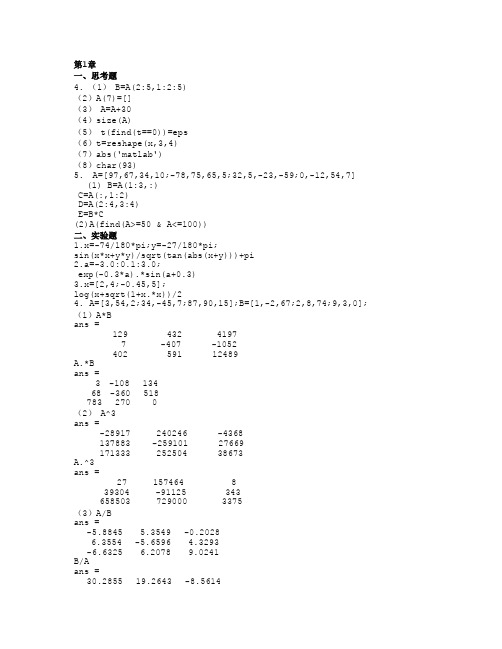
第1章一、思考题4. (1) B=A(2:5,1:2:5)(2)A(7)=[](3) A=A+30(4)size(A)(5) t(find(t==0))=eps(6)t=reshape(x,3,4)(7)abs('matlab')(8)char(93)5. A=[97,67,34,10;-78,75,65,5;32,5,-23,-59;0,-12,54,7](1) B=A(1:3,:)C=A(:,1:2)D=A(2:4,3:4)E=B*C(2)A(find(A>=50 & A<=100))二、实验题1.x=-74/180*pi;y=-27/180*pi;sin(x*x+y*y)/sqrt(tan(abs(x+y)))+pi2.a=-3.0:0.1:3.0;exp(-0.3*a).*sin(a+0.3)3.x=[2,4;-0.45,5];log(x+sqrt(1+x.*x))/24. A=[3,54,2;34,-45,7;87,90,15];B=[1,-2,67;2,8,74;9,3,0]; (1)A*Bans =129 432 41977 -407 -1052402 591 12489A.*Bans =3 -108 13468 -360 518783 270 0(2) A^3ans =-28917 240246 -4368137883 -259101 27669171333 252504 38673A.^3ans =27 157464 839304 -91125 343658503 729000 3375(3)A/Bans =-5.8845 5.3549 -0.20286.3554 -5.6596 4.3293-6.6325 6.2078 9.0241B/Aans =30.2855 19.2643 -8.561433.4394 21.1547 -9.3974-0.7443 -0.3938 0.2830(4)[A,B]ans =3 54 2 1 -2 6734 -45 7 2 8 7487 90 15 9 3 0[A([1,3],:);B^2]ans =3 54 287 90 15600 183 -81684 282 72615 6 8255.a=1+2i;b=3+4i;c=exp(pi*i/6)c =0.8660 + 0.5000ic+a*b/(a+b)ans =1.6353 + 1.8462i第2章一、思考题3.s=0;for n=0:63s=s+2^n;enddisp(s)n=0:63;s=sum(2.^n)二、实验题1.x=input('输入一个四位整数:');y=[fix(x/1000),mod(fix(x/100),10),mod(fix(x/10),10),mod(x,10)] z=mod((y+7),10)x=z(3)*1000+z(4)*100+z(1)*10+z(2)2.gh=input('输入工号');h=input('输入工时');dj=84;if h>120gz=dj*120+1.15*dj*(h-120);elseif h<60gz=dj*h-700;elsegz=dj*h;endformat bank;display([gh,gz])3.循环结构n=input('input n:');s=0;for k=1:ns=s+1/k^2;enddisplay(sqrt(s*6))向量运算n=input('input n:');k=1:n;display(sqrt(sum(1./k.^2)*6))4.y=0;k=0;while y<3k=k+1;y=y+1/(2*k-1);enddisplay([k-1,y-1/(2*k-1)])5.x0=0;x=1;k=0;a=input('a=');b=input('b=');while abs(x-x0)>=1e-5 && k<500x0=x;x=a/(b+x0);k=k+1;enddisplay([k,x]);display([(-b+sqrt(b^2+4*a))/2,(-b-sqrt(b^2+4*a))/2]);6.y=fun(40)/(fun(30)+fun(20))(1)函数文件fun.mfunction f=fun(n)f=n+log(n^2+5);(2)函数文件fun.mfunction f=fun(n)a=1:n;f=sum(a.*(a+1));第3章一、思考题4.t=0:0.01:1.5;y=sqrt(3)/2*exp(-4*t).*sin(4*sqrt(3)*t+pi/3);5.x=-10:0.01:10;y=linspace(-6,6,size(x,2))z=x.^3+3*x.*y.^2;plot3(x,y,z)6.x=100:100:400;y=100:100:400;z=[636,697,624,478;698,712,630,478;680,674,598,412;662,626,552,334]; [X,Y]=meshgrid(x,y);mesh(X,Y,z)二、实验题1.(1)x=-10:0.01:10;plot(x,x-x.^3/3/2)(2)plot(x,exp(-x.*x/2)/2/pi)(3)x=-8:0.01:8;plot(x,sqrt((64-x.*x)/2))(4)t=0:pi/100:6*pi;plot(t.*sin(t),t.*cos(t))2. (1)x1=linspace(0,1,100);y1=2*x1-0.5;t=linspace(0,pi,100);x=sin(3*t).*cos(t);y=sin(3*t).*sin(t);plot(x1,y1,'r-',x,y,'b:');text(0.4,1,'y=2x-0.5');text(-0.4,0.5,'x=sin(3t)cos(t)');text(-0.4,0.3,'y=sin(3t)sin(t)');(2)subplot(1,2,1);scatter(x1,y1,10)title('y=2x-0.5');subplot(1,2,2);scatter(x,y,10)3.subplot(1,21);x=1:1:100; y=sin(1./x);plot(x,y)subplot(1,2,2);fplot('sin(1/x)',[1,100])4.subplot(2,2,1);bar(t,y);subplot(2,2,2);stairs(t,y);subplot(2,2,3);stem(t,y)subplot(2,2,4);semilogy(t,y);5.theta=linspace(-pi,pi,100);ro=5.*cos(theta)+4;polar(theta,ro);fi=linspace(0,2*pi,100);a=1r=a.*(1+cos(fi));polar(fi,r);6.t=0:pi/20:2*pi;x=exp(-t./20).*cos(t);y=exp(-t./20).*sin(t);z=t; plot3(x,y,z);t=0:0.01:1;x=t;y=t.^2;z=t.^3;plot3(x,y,z);7.x=-30:0.1:0;y=0:0.1:30;[x,y]=meshgrid(x,y);z=10.*sin(sqrt(x.^2+y.^2))./sqrt(1+x.^2+y.^2); meshc(x,y,z);8.x=linspace(-3,3,100);y=linspace(-3,3,100);[x y]=meshgrid(x,y);fxy=-5./(1+x.^2+y.^2);i=find(abs(x)<=0.8 & abs(y)<=0.5);fxy(i)=NaN;surf(x,y,fxy)9.u=linspace(1,10,100);v=linspace(-pi,pi,100);[u,v]=meshgrid(u,v);x=3.*u.*sin(v);y=2.*u.*cos(v);z=4*u.^2;x=3*u.*sin(v);y=2*u.*cos(v);z=4*u.^2;surf(x,y,z);shading interp;light('position',[1,0,1]);10.t=0:pi/100:2*pi;y=sin(t);comet(t,y)第4章一、思考题5.(1)A=eye(3);(2)C=100+(200-100)*rand(5,6);(3)D=1+sqrt(0.2)*randn(1,500);(4)E=ones(size(A));(5)A=A+30*eye(size(A));(6)B=diag(diag(A))二、实验题1.P=pascal(5);H=hilb(5);Dp=det(P);Dh=det(H);Kp=cond(P);Kh=cond(H);P矩阵的性能更好,因为Kp较小2.A=[1,-1,2,3;0,9,3,3;7,-5,0,2;23,6,8,3]B=[3,pi/2,45;32,-76,sqrt(37);5,72,4.5e-4;exp(2),0,97]A1=diag(A);B1=diag(B);A2=triu(A);B2=triu(B);A3=tril(A);B3=tril(B);rA=rank(A);rB=rank(B);nA=norm(A);nb=norm(B);cA=cond(A);cB=cond(B);3.A=[31,1,0;-4,-1,0;4,-8,-2];[V,D]=eig(A);4.A=diag([-1,-1,-1,-1],-1)+diag([-1,-1,-1,-1],1)+diag([2,2,2,2,2]) b=[1,0,0,0,0]';x1=inv(A)*b;x2=A\b;[L,U]=lu(A);x3=U\(L\b);[Q,R]=qr(a);[Q,R]=qr(A);x4=R\(Q\b)R=chol(A);x5=R\(R'\b)5.B=sparse(A);x1=inv(B)*b;x2=B\b;[L,U]=lu(B);x3=U\(L\b);第5章一、思考题3.A=randn(10,5);mean(A)std(A)max(max(A))min(min(A))sum(A,2)sum(sum(A))sort(A,1)sort(A,2,'descend')二、实验题1.A=rand(1,30000);mean(A)std(A)max(A)min(A)size(find(A>0.5))/size(A)2.h=[466,715,950,1422,1635];w=[7.04,4.28,3.40,2.52,2.13];hh=[500,900,1500];ww=interp1(h,w,hh,'spline')3.x=linspace(1,10,50);y=log(x);f=polyfit(x,y,5);yy=polyval(f,x);plot(x,y,'r-',x,yy,'g.')4.N=64; % 采样点数T=5; % 采样时间终点t=linspace(0,T,N); % 给出N个采样时间ti(I=1:N) x=3*exp(-t); % 求各采样点样本值xdt=t(2)-t(1); % 采样周期f=1/dt; % 采样频率(Hz)X=fft(x); % 计算x的快速傅立叶变换XF=X(1:N/2+1); % F(k)=X(k)(k=1:N/2+1) f=f*(0:N/2)/N; % 使频率轴f从零开始plot(f,abs(F),'-*') % 绘制振幅-频率图xlabel('Frequency');ylabel('|F(k)|')5.(1)p1=[1 2 0 0 7];p2=[1 -2];p3=[1 0 0 5 1];p12=conv(p1,p2);p=p12+[zeros(1,size(p12,2)-size(p3,2)),p3];roots(p)(2)A=[-1,4,3;2,1,5;0,5,6];Px=polyval(p,A)Pxm=polyvalm(p,A)6.(1)z=fzero('3*x-sin(x)+1',0)(2)建立函数文件myfun.mfunction F=myfun(X)x=X(1);y=X(2);F(1)=x*x+y*y-9;F(2)=x+y-1;在命令窗口中输入以下命令:x=fsolve(@myfun,[3,0]',optimset('Display','off')) 第6章一、思考题2.fx=inline('1./(1+x.^2)');[I,n]=quad(fx,-100000,100000,1e-3);[I,n]=quadl(fx,-100000,100000,1e-3);x=-100000:0.01:100000;y=1./(1+x.*x);trapz(x,y);3.(1)fx=inline('-2*y+2*x*x+2*x');[t,y]=ode23(fx,[0,0.5],1)(2)fx=inline('y-exp(x)*cos(x)');[t,y]=ode23(fx,[0,3],1)二、实验题1.for x=1:3fx=[x,x^2,x^3;1,2*x,3*x;0,2,6*x];diff(fx)end2.(1)x=0:0.01:1;y=x.^10+10.^x+1./log10(x);dy=diff(y)/0.01;(2)x=0:0.01:1;y=log(1+x);dy=diff(y,2)/0.01;plot(x(1:99),dy)3.(1)fx=inline('x.^2.*sqrt(2*x.*x+3)');quad(fx,1,5)(2)fx=inline('x./sin(x).^2');quad(fx,pi/4,pi/3)(3)fx=inline('abs(cos(x+y))');dblquad(fx,0,pi,0,pi)(4)syms x y ;fx=x*y;int(int(fx,y^2,y+2),-1,2)x 的积分区间为【0,2】时fx=inline('x.*y');dblquad(fx,0,2,-1,2)4. x=0.3:0.2:1.5;y=[0.3895,0.6598,0.9147,1.1611,1.3971,1.6212,1.8325]; trapz(x,y)5.(1)yp=inline('-(1.2+sin(10*x))*y');[t,y]=ode23(yp,[0,5],1);(2)令''3,,21y x y x y x ='==,则可写出原方程的状态方程形式: 123233221sin 31)1(2cos 5cos x t x x t t t x x x x x +--++='='='⎥⎥⎥⎦⎤⎢⎢⎢⎣⎡+⎥⎥⎥⎦⎤⎢⎢⎢⎣⎡⎥⎥⎥⎥⎥⎦⎤⎢⎢⎢⎢⎢⎣⎡+-+-=⎥⎥⎥⎥⎦⎤⎢⎢⎢⎢⎣⎡'''t x x x t t tx x x cos 00)1(2cos 51sin 311000103212321 建立函数文件ztfun.m function y=ztfun(t,x)b=[0;0;cos(t)];y=[0,1,0;0,0,1;-1/(3+sin(t)),-1,5*cos(2*t)/(t+1)^2]*x+b; 解微分方程组[t,y]=ode23(@ztfun,[0,5],[1;0;2]);6.建立函数文件ztfun.mfunction yy=ztfun(t,y) yy=[y(2)*y(3);-y(1)*y(3);-0.51*y(1)*y(2)];解微分方程组 [t,y]=ode23(@ztfun,[0,5],[0;1;1])第7章一、思考题3.(1)数值积分fx=inline('exp(x).*(1+exp(x)).^2');quad(fx,0,log(2))符号积分f=sym('exp(x)*(1+exp(x))^2');v=int(f,0,log(2));eval(v)(2)略二、实验题1.A=sym('[1,2,3;x,y,z;3,2,1]')rank(A)inv(A)det(A)2.(1) y=sym('sqrt(x+sqrt(x+sqrt(x)))');y1=diff(y)y2=diff(y,'x',2)(2) syms x y;fxy=sin(x^2*y)*exp(-x^2-y);diff(diff(fxy,x),y)3.(1) syms xint(1/(1+x^4))(2) syms x tint((-2*x*x+1)/(2*x*x-3*x+1)^2,x,cos(t),exp(2*t)) 4.syms n xsymsum(1/(2*n+1)/(2*x+1)^(2*n+1),n,0,inf)symsum(1/(2*n+1)/(2*x+1)^(2*n+1),n,0,5)5.(1) syms xtaylor((exp(x)+exp(-x))/2,5,0)(2) syms a xtaylor(exp(-5*x)*sin(3*x+pi/3),5,a)6.(1)x=solve(sym('x^3+a*x+1=0'))(2)[x y]=solve('sqrt(x^2+y^2)-100=0,3*x+5*y-8=0')7. 方程转化为: π21'11't y y y y -=+=⎩⎨⎧符号解[y1,y11]=dsolve('Dy=y1,Dy1+y=1-t^2/pi','y(-2)=5,y1(-2)=5','t') 数值解编写函数文件ztfun.mfunction yy=ztfun(t,y)yy=[y(2);1-t^2/pi-y(1)];在命令窗口输入以下命令[t,y]=ode45(@ztfun,[-2,7],[-5;5]);t=linspace(-2,7,49)y2=y8.[x,y]=dsolve('Dx=3*x+4*y,Dy=-4*x+3*y','x(0)=0,y(0)=1')。
MATLAB基础与应用教程教学课件ppt蔡旭晖刘卫国蔡立燕习题答案第9-12章答案
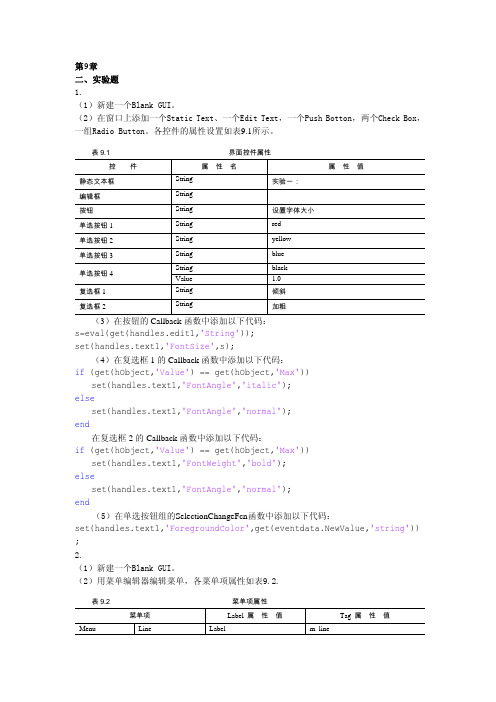
第9章二、实验题1.(1)新建一个Blank GUI。
(2)在窗口上添加一个Static Text、一个Edit Text,一个Push Botton,两个Check Box,一组Radio Button。
各控件的属性设置如表9.1所示。
表9.1界面控件属性控件属性名属性值静态文本框String实验一:编辑框String按钮String设置字体大小单选按钮1String red单选按钮2String yellow单选按钮3String blue单选按钮4String black Value 1.0复选框1String倾斜复选框2String加粗(3)在按钮的Callback函数中添加以下代码:s=eval(get(handles.edit1,'String'));set(handles.text1,'FontSize',s);(4)在复选框1的Callback函数中添加以下代码:if(get(hObject,'Value')==get(hObject,'Max'))set(handles.text1,'FontAngle','italic');elseset(handles.text1,'FontAngle','normal');end在复选框2的Callback函数中添加以下代码:if(get(hObject,'Value')==get(hObject,'Max'))set(handles.text1,'FontWeight','bold');elseset(handles.text1,'FontAngle','normal');end(5)在单选按钮组的SelectionChangeFcn函数中添加以下代码:set(handles.text1,'ForegroundColor',get(eventdata.NewValue,'string')) ;2.(1)新建一个Blank GUI。
MATLAB语言基础与应用(第二版)第1章 习题答案
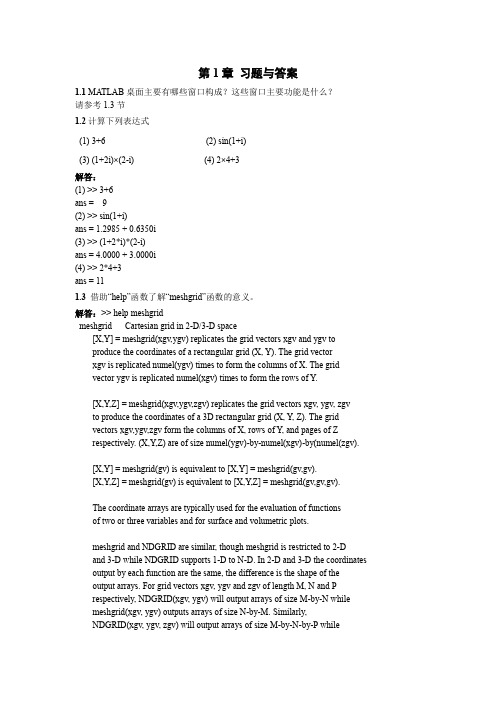
第1章习题与答案1.1 MA TLAB桌面主要有哪些窗口构成?这些窗口主要功能是什么?请参考1.3节1.2计算下列表达式(1) 3+6 (2) sin(1+i)(3) (1+2i)×(2-i) (4) 2×4+3解答:(1) >> 3+6ans = 9(2) >> sin(1+i)ans = 1.2985 + 0.6350i(3) >> (1+2*i)*(2-i)ans = 4.0000 + 3.0000i(4) >> 2*4+3ans = 111.3借助“help”函数了解“meshgrid”函数的意义。
解答:>> help meshgridmeshgrid Cartesian grid in 2-D/3-D space[X,Y] = meshgrid(xgv,ygv) replicates the grid vectors xgv and ygv toproduce the coordinates of a rectangular grid (X, Y). The grid vectorxgv is replicated numel(ygv) times to form the columns of X. The gridvector ygv is replicated numel(xgv) times to form the rows of Y.[X,Y,Z] = meshgrid(xgv,ygv,zgv) replicates the grid vectors xgv, ygv, zgvto produce the coordinates of a 3D rectangular grid (X, Y, Z). The gridvectors xgv,ygv,zgv form the columns of X, rows of Y, and pages of Zrespectively. (X,Y,Z) are of size numel(ygv)-by-numel(xgv)-by(numel(zgv).[X,Y] = meshgrid(gv) is equivalent to [X,Y] = meshgrid(gv,gv).[X,Y,Z] = meshgrid(gv) is equivalent to [X,Y,Z] = meshgrid(gv,gv,gv).The coordinate arrays are typically used for the evaluation of functionsof two or three variables and for surface and volumetric plots.meshgrid and NDGRID are similar, though meshgrid is restricted to 2-Dand 3-D while NDGRID supports 1-D to N-D. In 2-D and 3-D the coordinates output by each function are the same, the difference is the shape of theoutput arrays. For grid vectors xgv, ygv and zgv of length M, N and Prespectively, NDGRID(xgv, ygv) will output arrays of size M-by-N whilemeshgrid(xgv, ygv) outputs arrays of size N-by-M. Similarly,NDGRID(xgv, ygv, zgv) will output arrays of size M-by-N-by-P whilemeshgrid(xgv, ygv, zgv) outputs arrays of size N-by-M-by-P.Example: Evaluate the function x*exp(-x^2-y^2)over the range -2 < x < 2, -4 < y < 4,[X,Y] = meshgrid(-2:.2:2, -4:.4:4);Z = X .* exp(-X.^2 - Y.^2);surf(X,Y,Z)Class support for inputs xgv,ygv,zgv:float: double, singleinteger: uint8, int8, uint16, int16, uint32, int32, uint64, int64 See also surf, slice, ndgrid.Overloaded methods:codistributed/meshgridgpuArray/meshgridReference page in Help browserdoc meshgrid1.4通过帮助浏览器窗口了解函数sin和cos。
MATLAB程序设计及应用(第二版)课后实验答案(最新整理)
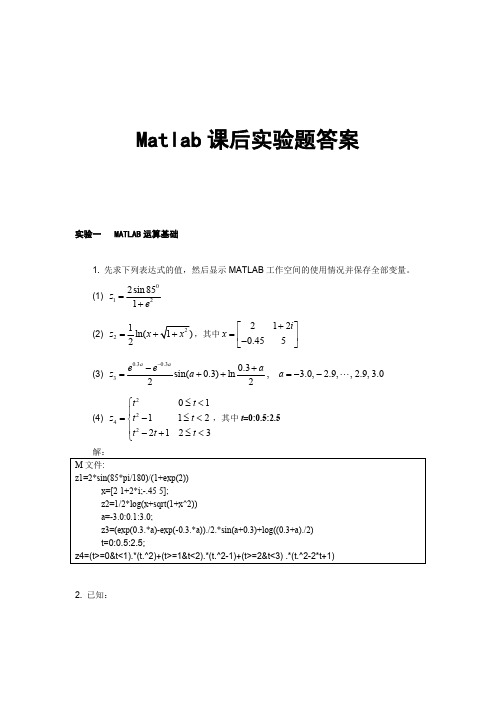
阵和对角阵,试通过数值计算验证。
22E R RS A OS +⎡⎤=⎢⎥⎣⎦解: M 文件如下;由ans,所以22E R RS A O S +⎡⎤=⎢⎥⎣⎦2. 产生5阶希尔伯特矩阵H 和5阶帕斯卡矩阵P ,且求其行列式的值Hh 和Hp 以及它们的条件数Th 和Tp ,判断哪个矩阵性能更好。
为什么?解:M 文件如下:因为它们的条件数Th>>Tp,所以pascal 矩阵性能更好。
3. 建立一个5×5矩阵,求它的行列式值、迹、秩和范数。
解: M 文件如下:4. 已知2961820512885A -⎡⎤⎢⎥=⎢⎥⎢⎥-⎣⎦求A 的特征值及特征向量,并分析其数学意义。
解:M 文件如图:数学意义:V的3个列向量是A的特征向量,D的主对角线上3个是A的特征值,特别的,的3个列向量分别是D的3个特征值的特征向量。
5. 下面是一个线性方程组:111⎡⎤输出结果:由结果,X和X2的值一样,这表示b的微小变化对方程解也影响较小,而A的条件数算得较小,所以数值稳定性较好,A是较好的矩阵。
6. 建立A矩阵,试比较sqrtm(A)和sqrt(A),分析它们的区别。
解:M文件如下:分析结果知:sqrtm(A)是类似A的数值平方根(这可由b1*b1=A的结果看出),而sqrt(A)则是对A中的每个元素开根号,两则区别就在于此。
实验三 选择结构程序设计1. 求分段函数的值。
2226035605231x x x x y x x x x x x x ⎧+-<≠-⎪=-+≤<≠≠⎨⎪--⎩且且及其他用if 语句实现,分别输出x=-5.0,-3.0,1.0,2.0,2.5,3.0,5.0时的y 值。
解:M文件如下:2. 输入一个百分制成绩,要求输出成绩等级A 、B 、C 、D 、E 。
其中90分~100分为A ,80分~89分为B ,79分~79分为C ,60分~69分为D ,60分以下为E 。
要求:(1) 分别用if 语句和switch 语句实现。
matlab基础及其应用教程曾霞答案

MATLAB主窗口☐功能区☐快速访问工具栏☐当前文件夹工具栏命令行窗口命令行窗口用于输入命令并显示命令的执行结果。
命令行窗口续行符当前文件夹窗口工作区窗口>> A=[4,2;3,6]A =4 23 6>> B=exp(A)B =54.5982 7.389120.0855 403.4288 常用数学函数(1)函数的调用格式为:函数名(函数自变量的值)函数在运算时是将函数逐项作用于矩阵 的每个元素上,所以最后运算的结果就 是一个与自变量同型的矩阵。
(2)常用函数的应用①三角函数有以弧度为单位的函数和以角度为单位的函数,如果是以角度为单位的函数就在函数名后面加“d”,以示区别。
>> sin(pi/2)ans =1>> sind(90)ans =1② abs函数可以求实数的绝对值、复数的模。
>> abs(-4)ans =4>> abs(3+4i)ans =5>> abs('a')ans =97赋值语句两种格式:☐变量=表达式☐表达式1+ x−y计算表达式5+cos 47°的值,并将结果赋给变量z,然后显示计算结果。
其中,x =π7 − 2i, y = e2 。
>> x=sqrt(7)-2i;>> y=exp(pi/2);>> z=(5+cosd(47))/(1+abs(x-y)) z =1.4395预定义变量预定义变量是在MATLAB工作空间中驻留,由系统本身定义的变量。
☐ans是默认赋值变量☐i和j代表虚数单位☐pi代表圆周率☐NaN代表非数内存变量文件用于保存MATLAB工作区变量的文件叫做内存变量文件,其扩展名为.mat ,也叫MAT文件。
矩阵的建立(1)利用直接输入法建立矩阵:将矩阵的元素用中括号括起来,按矩阵行的顺序输入各元素,同一行的各元素之间用逗号或空格分隔,不同行的元素之间用分号分隔。
- 1、下载文档前请自行甄别文档内容的完整性,平台不提供额外的编辑、内容补充、找答案等附加服务。
- 2、"仅部分预览"的文档,不可在线预览部分如存在完整性等问题,可反馈申请退款(可完整预览的文档不适用该条件!)。
- 3、如文档侵犯您的权益,请联系客服反馈,我们会尽快为您处理(人工客服工作时间:9:00-18:30)。
402
591
12489
A.*B
ans =
3 -108 134
68 -360 518
783 270 0
(2) A^3
ans =
-28917
240246
-4368
137883 -259101
27669
171333
252504
38673
A.^3
ans =
27
157464
8
39304
-91125
343
658503
nA=norm(A);nb=norm(B); cA=cond(A);cB=cond(B); 3. A=[31,1,0;-4,-1,0;4,-8,-2]; [V,D]=eig(A); 4. A=diag([-1,-1,-1,-1],-1)+diag([-1,-1,-1,-1],1)+diag([2,2,2,2,2])
8. x=linspace(-3,3,100);y=linspace(-3,3,100); [x y]=meshgrid(x,y); fxy=-5./(1+x.^2+y.^2); i=find(abs(x)<=0.8 & abs(y)<=0.5);
fxy(i)=NaN; surf(x,y,fxy) 9. u=linspace(1,10,100);v=linspace(-pi,pi,100); [u,v]=meshgrid(u,v); x=3.*u.*sin(v);y=2.*u.*cos(v);z=4*u.^2; x=3*u.*sin(v);y=2*u.*cos(v);z=4*u.^2; surf(x,y,z);shading interp; light('position',[1,0,1]); 10.
stem(t,y) subplot(2,2,4); semilogy(t,y); 5. theta=linspace(-pi,pi,100); ro=5.*cos(theta)+4; polar(theta,ro); fi=linspace(0,2*pi,100);a=1 r=a.*(1+cos(fi)); polar(fi,r);
6.
y=fun(40)/(fun(30)+fun(20)) (1)函数文件fun.m function f=fun(n) f=n+log(n^2+5); (2)函数文件fun.m function f=fun(n) a=1:n; f=sum(a.*(a+1));
第 3章 一、思考题
4. t=0:0.01:1.5; y=sqrt(3)/2*exp(-4*t).*sin(4*sqrt(3)*t+pi/3); 5. x=-10:0.01:10; y=linspace(-6,6,size(x,2)) z=x.^3+3*x.*y.^2; plot3(x,y,z) 6. x=100:100:400; y=100:100:400; z=[636,697,624,478;698,712,630,478;680,674,598,412;662,626,552,334]; [X,Y]=meshgrid(x,y); mesh(X,Y,z) 二、实验题 1. (1)x=-10:0.01:10;
b=[1,0,0,0,0]'; x1=inv(A)*b; x2=A\b; [L,U]=lu(A); x3=U\(L\b); [Q,R]=qr(a); [Q,R]=qr(A);
x4=R\(Q\b)
R=chol(A);
x5=R\(R'\b)
5.
B=sparse(A);
x1=inv(B)*b;
x2=B\b;
exp(-0.3*a).*sin(a+0.3)
3.x=[2,4;-0.45,5];
log(x+sqrt(1+x.*x))/2
4. A=[3,54,2;34,-45,7;87,90,15];B=[1,-2,67;2,8,74;9,3,0];
(1)A*B
ans =
129
432
4197
7
-407-1052来自plot(x,x-x.^3/3/2) (2)plot(x,exp(-x.*x/2)/2/pi) (3)x=-8:0.01:8; plot(x,sqrt((64-x.*x)/2)) (4)t=0:pi/100:6*pi; plot(t.*sin(t),t.*cos(t)) 2. (1) x1=linspace(0,1,100); y1=2*x1-0.5; t=linspace(0,pi,100); x=sin(3*t).*cos(t);y=sin(3*t).*sin(t); plot(x1,y1,'r-',x,y,'b:'); text(0.4,1,'y=2x-0.5'); text(-0.4,0.5,'x=sin(3t)cos(t)'); text(-0.4,0.3,'y=sin(3t)sin(t)'); (2)
subplot(1,2,1); scatter(x1,y1,10)
title('y=2x-0.5'); subplot(1,2,2); scatter(x,y,10) 3.
subplot(1,21); x=1:1:100; y=sin(1./x); plot(x,y) subplot(1,2,2); fplot('sin(1/x)',[1,100]) 4. subplot(2,2,1); bar(t,y); subplot(2,2,2); stairs(t,y); subplot(2,2,3);
t=0:pi/100:2*pi; y=sin(t); comet(t,y) 第 4章 一、思考题
5. (1)A=eye(3); (2)C=100+(200-100)*rand(5,6); (3)D=1+sqrt(0.2)*randn(1,500); (4)E=ones(size(A)); (5)A=A+30*eye(size(A)); (6)B=diag(diag(A)) 二、实验题
3 54 2 1 -2 67 34 -45 7 2 8 74 87 90 15 9 3 0 [A([1,3],:);B^2] ans =
3 54 2 87 90 15 600 183 -81 684 282 726 15 6 825 5.a=1+2i;b=3+4i; c=exp(pi*i/6) c= 0.8660 + 0.5000i c+a*b/(a+b) ans = 1.6353 + 1.8462i 第 2章 一、思考题 3.s=0; for n=0:63 s=s+2^n; end disp(s)
1. P=pascal(5);H=hilb(5); Dp=det(P);Dh=det(H);
Kp=cond(P);Kh=cond(H); P 矩阵的性能更好,因为 Kp 较小 2. A=[1,-1,2,3;0,9,3,3;7,-5,0,2;23,6,8,3] B=[3,pi/2,45;32,-76,sqrt(37);5,72,4.5e-4;exp(2),0,97] A1=diag(A);B1=diag(B); A2=triu(A);B2=triu(B); A3=tril(A);B3=tril(B); rA=rank(A);rB=rank(B);
[L,U]=lu(B);
x3=U\(L\b); 第 5章
一、思考题
3.
A=randn(10,5);
mean(A)
std(A)
max(max(A))
min(min(A))
sum(A,2)
sum(sum(A))
sort(A,1)
sort(A,2,'descend')
二、实验题
1. A=rand(1,30000);
729000
3375
(3)A/B
ans =
-5.8845 5.3549 -0.2028
6.3554 -5.6596 4.3293
-6.6325 6.2078 9.0241
B/A
ans =
30.2855 19.2643 -8.5614
33.4394 21.1547 -9.3974 -0.7443 -0.3938 0.2830 (4)[A,B] ans =
第 1章
一、思考题
4. (1) B=A(2:5,1:2:5)
(2)A(7)=[]
(3) A=A+30
(4)size(A)
(5) t(find(t==0))=eps
(6)t=reshape(x,3,4)
(7)abs('matlab')
(8)char(93)
5. A=[97,67,34,10;-78,75,65,5;32,5,-23,-59;0,-12,54,7]
x=3*exp(-t); % 求各采样点样本值x
dt=t(2)-t(1); f=1/dt;
% 采样周期 % 采样频率(Hz)
X=fft(x);
% 计算x的快速傅立叶变换X
F=X(1:N/2+1); f=f*(0:N/2)/N;
% F(k)=X(k)(k=1:N/2+1) % 使频率轴f从零开始
plot(f,abs(F),'-*')
% 绘制振幅-频率图
xlabel('Frequency');
n=0:63; s=sum(2.^n) 二、实验题 1. x=input('输入一个 四位整 数:'); y=[fix(x/1000),mod(fix(x/100),10),mod(fix(x/10),10),mod(x,10)] z=mod((y+7),10) x=z(3)*1000+z(4)*100+z(1)*10+z(2) 2. gh=input('输入工号'); h=input('输入工时'); dj=84; if h>120
